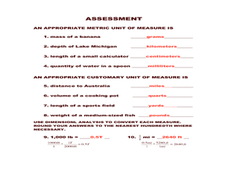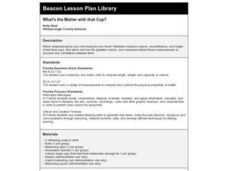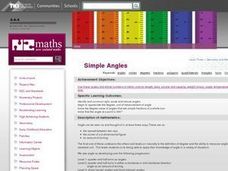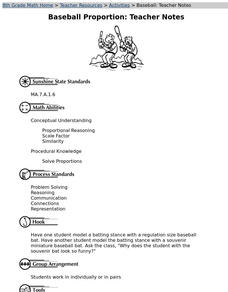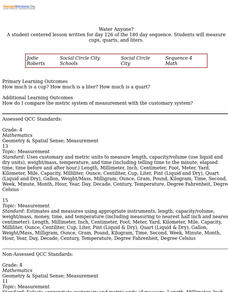Curated OER
Algebra/Geometry Institute: Area, Circumference, Perimeter
Students solve area problems. In this area, circumference, and perimeter lesson, students solve area and perimeter problems using standard and metric units of measure. They identify the best customary unit of measure for a...
Curated OER
Genetic Variations in Hand Span Size
Students study genes. In this biology lesson plan, students measure their handspan size to determine if one pair or many pairs of genes control that trait.
Curated OER
Leaping Lemurs! How far can you jump?
Students watch a segment of the PBS video which show the lemurs' ability to jump. In pairs, students collect measurement data involving each other's length of a standard step, a standing broad jump, and a long jump. They record their...
Curated OER
What's the Matter with that Cup?
Fourth graders measure volume, circumference, and height of fast food cups, find which one has the greatest volume, and compare/contrast those measurements to discover any correlations between them.
Curated OER
Simple Angles
Third graders identify and construct right, acute and obtuse angles and begin to appreciate the degree and unit of measurement of angle. They know the degree value of angles that are simple fractions of a whole turn know that the angle...
Curated OER
Shaquille O'Neal Hand/Foot Span
Eighth graders measure foot length and hand span in this experiment to determine the ratio. They apply the ratio to determine Shaquille O'Neal's hand span if given his shoe size.
Curated OER
Baseball Proportion
Eighth graders measure regular baseball bats and souvenir bats in centimeters. They determine how tall a person would be to be in proportion to the souvenir bat, create a poster depicting the person, and explain the proportional...
Curated OER
Circles Minilab
Young scholars learn how to measure the diameter and circumference of a circle. In this circle lesson, students organize their data to create a graph. Young scholars utilize their graph to make an inference about the slope of pi.
Curated OER
Puzzling Perimeters
Third graders use estimation, fractions and decimals to determine the perimeter of objects in the classroom. They are given a worksheet with a list of the items on it. The worksheet has columns beside each of the items for estimation and...
Curated OER
Hop To It!
Students explore the aspects of a frog's anatomy that allow it to be such a good jumper and jump and record the length of each jump to determine which style of jumping allows them to jump the farthest.
Curated OER
Mathematics In You
Young scholars construct ratios using the hand as data. They use examples of cortical and trabecular bone found in the long bones to measure circumference, diameter, length, and weight of long bones. They perform computations using...
Curated OER
FOOTSTEPS IN TIME
Students measure and correlate their foot lengths and body heights, then use this data to estimate height of Laetoli hominids. They use metric measurement and graphing to determine these heights.
Curated OER
Whose Skeleton is in Your Closet?
Students analyze and measure parts of a model skeleton to determine sex, race, height and age. They produce a lab report from their inquiries.
Curated OER
Building a Scale Model
Third graders create a model of the solar system. In this solar system lesson, 3rd graders create a scale model of the solar system. Working in pairs students solve mathematical problems to correctly measure the distance each planet is...
Curated OER
Cool Times with Heat
Students work with thermometers to complete problems about temperature. They investigate cooling patterns, how location affects temperature, and what happens when water having different temperature is mixed. They measure temperature in...
Curated OER
Garden Variety Geometry
Learners prepare to take the GED by reviewing basic math concepts. In this geometry lesson, students review vocabularies such as formula, perimeter, circumference and other important geometric terms. They convert between the English and...
Curated OER
Weight
In this estimating weights of objects worksheet, learners observe objects, estimate the metric measurements, and choose the best answer. Students solve 9 problems.
Curated OER
How do You Stack Up? Revisited
Students estimate the thickness of coins. In this stack up lesson, students stack pennies, nickels, dimes and quarters. They calculate and record the thickness of each coin. Students stack coins and estimate the height of the stack.
Curated OER
Classroom Meteorologists: An Experiential Approach to Learning about Seasons and Weather
Students examine several concepts about weather in the seven lessons of this unit. This year long activity helps students to gather data seasonally about wind, clouds, precipitation, and temperature. Earth's three climate zones are...
Curated OER
Oranges and Stopwatches
Students begin to recognize that objects have many measurable attributes. They examine how to identify and accurately measure attributes of common objects. Also Students report their measurement findings.
Pennsylvania Department of Education
The Weight of Things
Students explore weight. In this math lesson, students predict which item weighs more and discuss how they arrived at their decision. Students weigh several items to determine which weighs more.
Curated OER
Ratios
Students explore the concept of ratios. In this ratios lesson plan, students use matchbox cars and models of spaceships to explore ratios. Students determine scale for the above mentioned objects in this lecture style lesson plan.
Curated OER
How far is a km?
Students explore the size of a kilometer and the time it takes to cover this distance. They develop a concept of a km. They measure a distance of 1 km and the time taken to cover it.


